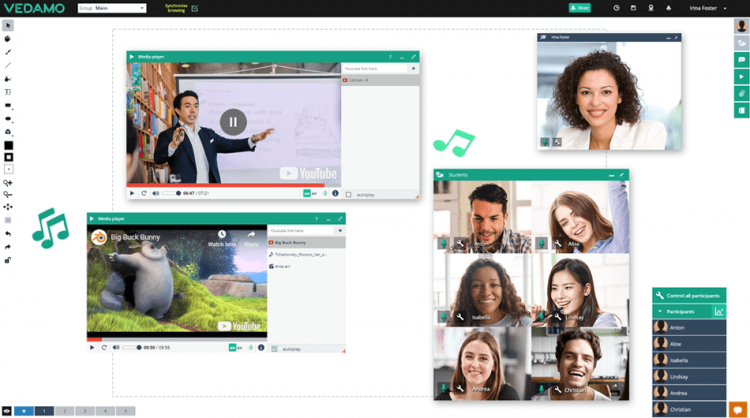To create the perfect online training content may be difficult and time consuming. However, it doesn’t mean that you have to be hard at work continuously searching for newer and newer topics for your practice. On the contrary, most experienced online tutors are experts in a certain area. Therefore, it is best for them and their online students to benefit from their deep expertise. On the other hand, being stuck using the very same content will soon bore you. Fortunately, there are some ways that you can create a new online training by modifying an older one.
Consider different audiences for your online training
This does not mean that you will offer the very same content to different people. It means that by changing your online students you will have a new perspective on your own practice. Choosing a different target audience will lead to modifying your online training accordingly.

Pay attention to the knowledge level of the online students. Your online practice may have to be structured completely differently if the levels of your online students varies. Don’t forget to rethink your marketing strategy too. Consider sending an email to everyone in your contact list. On the one hand, this will allow you to collect feedback that will help you with your next course. On the other, you can invite your audience to join you in your new virtual classroom adventure.
Engage your future audience with social media announcements – by knowing your audience better you will know which social channels they prefer. Create a poll or an ad. Moreover, you can use different groups to contact the right people.
Have a specific audience in mind. You can’t make everybody happy with your online training. However, make sure that you have narrowed it down and that you are offering something specific and exciting to your future online students.
Guiding questions:
- Who is the main target of your old training?
- Who is the secondary target?
- What kind of online student have you ignored in your old training?
- How can you split your audience: is age a factor, or maybe cultural background?
- Where can you reach your new online students: social media, magazines, forums, universities, etc.?

Change the perspective
When recreating an online training try to change the perspective. First, have all of your content as text. Then take a careful look. If your course structure is nearly perfect you should have 1-3 key topics.
Now, research the topic some more. Once you have a solid list of brand-owned resources about your topic, research other keywords and your competitor’s performance. You will surely find something unexpected. Identify the core of your training. Then, totally forget it. Use your old content as a starting point.
While researching, look for popular topics that other authors are covering. The best strategy is to find the missing piece in all of their topics. On the one hand, you have to build your training around something specific in a niche that others have not yet discovered. On the other, you have to be aware of the popularity of many different topics in order to guarantee the interest of your online students. Finally, validate your course topic. All you have to do is search the internet again to see what other people are looking for, clicking on, and engaging with.
Guiding questions
- What is the main topic of your online training?
- How many subtopics can you select?
- What are the interests of your audience?
- Which pieces of content are getting the most engagement and traffic?
- Does your training solve an educational issue or problem that people are having?
Dig deeper into a specific aspect
Identifying your core topic will give you the chance to create the appropriate structure for your online training. Once you have searched for the keywords that are related to your topic, you can start building a mind map. This technique combines both the logical and creative aspects of your idea.
You can also look at your comments and feedback from your old online training. Additionally, you can pay attention to comments and questions in social media regarding your performance. More frequently discussed topics or repetitive questions have the potential to turn into a new online tutoring practice. This might be a good place to start narrowing down a course topic. If you’re too broad, you’ll find yourself in the creation stage forever. Try to narrow it down to one specific transformation.
Additionally, figure out what is the easiest, fastest and least expensive piece of content to create. Thus, you will eliminate potential stumbling blocks.

Guiding questions:
- What types of questions are people asking you?
- What type of course will you enjoy creating the most?
- Which topics align with your long-term goals?
- Are there lots of people weighing in on a topic, but without offering conclusive answers?
- Do you notice a certain topic sparking a discussion or debate?
Create extra value
Your course is not merely educational content. It is the sum of all of its resources, multimedia formats, and any additional value that you pack your training with. Therefore, in order to create a new version of your old online training, you should follow the best practices.

Use multimedia
Consider turning your content into scripts. Additionally, find other suitable tools to translate knowledge to your online students. Show all that you have to say. The sky is the limit. Be as productive and creative as possible. Prevent your students from being bored. Try to surprise and challenge them. Occasionally change video formats. First, you can include video interviews, and then you can create quick entertaining videos. And this is only the beginning.
Create a great resource hub
Come up with extra downloadable content, or create the option for others to add their own findings that may help the rest of the group. This approach will give you the chance to reuse as much content as you want. Also, include quick tips and tricks in the content that can be used right away. Turn articles into pdf downloads, or create small bites of visual content into infographics. Everything your online students can use after the training is welcome.
Find supporters and use them as course motivators
Every expert in your field that can support you is highly welcome. Consider inviting a guest online tutor. Moreover, find influencers that are close to your audience’s interests, which will make your online students far more engaged and possibly lead to them learning other useful insights.
Add value to your new audience
The difference between your old and new online training can come from the overall value that you provide to your students. Whether it is a clear objective or the closed community that you create, find the value that will help turn your online students into loyal brand speakers.
Other useful tactics:
- Create opportunities for students to learn from each other
- Divide course content into modules
- Use clear and consistent organizational (visually and verbally) principles
- Create assignments close to real-world situations
- Match the learning material with your pre-defined goals and set clear expectations
Guiding questions:
- Which type of multimedia best suits your audience?
- How did they get the same info before?
- Can you change the previous pattern?
- What resources will be both interesting to and useful for your online students?
- Who are the influencers and the opinion leaders of your group?
